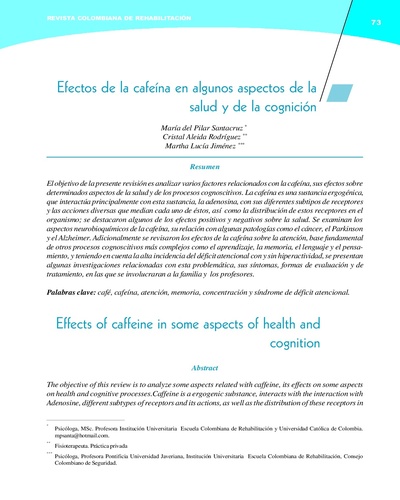Efectos de la cafeína en algunos aspectos de la salud y de la cognición
Contenido principal del artículo
Autores
María del Pilar Santacruzmpsanta@hotmail.com
Cristal Aleida Rodríguez
mpsanta@hotmail.com
Martha Lucía Jiménez
mpsanta@hotmail.com
Resumen
Palabras clave:
Detalles del artículo
Licencia
Aquellos autores/as que tengan publicaciones con esta revista, aceptan los términos siguientes:
- Los autores/as conservarán sus derechos de autor y garantizarán a la revista el derecho de primera publicación de su obra, el cuál estará simultáneamente sujeto a la Licencia de reconocimiento de Creative Commons que permite a terceros compartir la obra siempre que se indique su autor y su primera publicación esta revista.
- Los autores/as podrán adoptar otros acuerdos de licencia no exclusiva de distribución de la versión de la obra publicada (p. ej.: depositarla en un archivo telemático institucional o publicarla en un volumen monográfico) siempre que se indique la publicación inicial en esta revista.
- Se permite y recomienda a los autores/as difundir su obra a través de Internet (p. ej.: en archivos telemáticos institucionales o en su página web) antes y durante el proceso de envío, lo cual puede producir intercambios interesantes y aumentar las citas de la obra publicada. (Véase El efecto del acceso abierto).
Los autores que publican en la revista se acogen al código de licencia de Creative Commons Atribución 4.0 Internacional (CC BY 4.0)




Referencias
Agardh, E.E.; Carlsson, S. & Ahlbom, A. Coffee consumption, type 2 diabetes and impaired glucose tolerance in Swedish men and women. J Intern Med, 2004; 255: 645-652.
American Psychiatric Association. Manual diagnóstico y estadístico de los trastornos mentales (DSM IV). 1994.
Ascherio, A.; Zhang, S.M.; Hernán, M.A.; Kawachi, I.; Colditz, G.A.; Speizer, F.; Willett & W.C. Prospective study of caffeine consumption and risk of Parkinson’s disease in men and women. Annals of Neurology. 2001; 50: 56-63.
Baer Effects of caffeine on classroom behavior, sustained attention, and a memory task in preschool children. Journal Applicated Behavior Analysis. 1987; 20 (3): 225-234.
Baker, J.; Beehler, G.; Sawant, A.; Jayaprakash, V. et al. Premenopausal Breast Cancer. The Journal of Nutrition. Bethesda: Jan 2006; 136 (1): 166.
Barkley, R.A.; Du Paul, G.J. & Connor, D.F. Stimulants, in Practitioner’s Guide to Psychoactive Drugs for Children and Adolescents. 2nd edition, edited by Werry JS, Aman MG. New York, Plenum, 1999; 213-248.
Barranco, J.L.; Allam, M.F.; Serrano Del Castillo, R. & Fernández- Crehuet N. Alzheimer’s disease and coffee: a quantitative review. Neurological Research. Guildford: Jan 2007; 29 (1): 91, 5 p.
Barraquer, B. El sistema nervioso como un todo. La persona y su enfermedad. Barcelona: Paidós. 1995.
Bernstein, G.S.; Carroll, M.E. & Crosby, R.D. Caffeine effects on learning, performance, and anxiety in normal school-aged children. J Am Academic Child Adolescent Psychiatry. 1994; 33: 407-415.
Biaggoni, I.; Paul, S.; Puckett, A. & Arzubiaga, C. Caffeine & theophylline as adenosine receptor antagonists in humans. J Pharmacol Exp Ther 1991; 258: 588-593.
Blokland, A. Acetylcholine: a neurotransmitter for learning and memory? Brain Res Rev 1996; 21: 285-300.
Bravi, F.; Bosetti, C.; Tavani, A.; Bagnardi, V.; Gallus, S.; Negri, E. et al. Coffee drinking and hepatocellular carcinoma risk. Hepatology, 2007; 46 (2): 430-435.
Camaz, A. Effects of caffeine on visual evoked potential (P300) and neuromotor performance, Arqentina. Neuro-Psiquiatr. Instituto de Psiquiatria (IPUB), Setor de Neuroimagem Funcional, UFRJ. São Paulo jun. 2004; 62 (2b).
Carrasco, X.; Rothhammer, P.; Moraga, M.; Henrique, H.; Aboitiz, F. & Rothhammer, F. Presencia de los alelos DRD4/7R y DAT1/10R en miembros de familias chilenas con síndrome de déficit atencional con hiperactividad. Revista Médica de Chile, Santiago sep. 2004; 132 (9).
Carrillo, J.A. & Benítez, J. Clinically significant pharmacokinetic interactions between dietary caffeine and medications. Clin. Pharmacokinet, 2000; 39: 127-153.
Castellanos, F.X. & Rapoport, J.L. Effects of caffeine on development and behavior in infancy and childhood: a review of the published literature. Food Chem Toxicol, 2002; 40: 1235-1242.
Childs, E. & Wit, H. Subjective, behavioral, and physiological effects of acute caffeine in light, nondependent caffeine users. Psychopharmacology. 2006; 185: 514523.
Clements, S. Minimal Brain Dysfunction in children. N.I.N.D.S. monografía Nº 3 U.S. Depart of Health, Education and Welface. 1966.
Conney, A. Skin Cancer; Caffeine and exercise can team up to prevent skin cancer. Clinical Oncology Week. 2007; 54.
Engebretsen, K.M. & Harris, C.R. Caffeine and Related Nonprescription Sympathomimetics. In: Clinical Toxicology. Ford, M.D., et al. (eds.), W. B. Saunders, Philadelphia. 2001; 310-315.
Fredholm, B.; Chen, J.F.; Masino, S & Vaugeois, J.M. Actions of adenosine at its receptors in the cns: insights from knockouts and drugs. Annual Review of Pharmacology and Toxicology. 2005; 45, 385-413.
Gadow, K.D. Prevalence of drug therapy, in Practitioner’s Guide to Psychoactive Drugs for Children and Adolescents. Edited by Werry S.J., Aman M.G. New York, Plenum, 1993; 57-74.
Giovanucci, E. Meta-analysis of coffee consumption and risk of colorectal cancer. American Journal Epidemiology. 1998; 147: 1043-1052.
Goldstein, E.B. Sensación y percepción. Thomson Learning Ibero. ISBN 9706864865. 2005; 684 p.
Goodman, L.S. & Gilman, A. Las bases farmacológicas de la terapéutica. Ed. México: McGraw-Hill Interamericana. 2007.
Gotteland, M. & De Pablo V.S. Algunas verdades sobre el café. Revista Chilena de Nutrición. 2007; 34 (2): 105-115.
Green, P.J.; Kirby, R. & Suls, J. The effects of caffeine on blood pressure and heart rate: a review. Ann Behav Med 1996; 18: 201-216.
Greenhill, LL. Halperin, J.M. & Abikoff, H. Stimulant medications. J Am Academic Child Adolescent Psychiatry. 1999; 38: 503-512.
Higdon, J & Frei B. Coffe and health: a review of recent human research. Critical reviews in food sciences and nutrition 2006; 46, 101123.
Kavale, K. The efficacy of stimulant drug treatment for hyperactivity: a meta-analysis. J Learn Disabil 1982; 15: 280-289.
Koelega, H.S. Effects of caffeine, nicotine and alcohol on vigilance performance. In: Snel J., Lorist M. (eds.) Nicotine, caffeine and social drinking. OPA, Amsterdam, 1998; 363-373.
Levy, F. The dopamine theory of attention deficit hyperactivity disorder (ADHD). Aust N Z J Psychiatry 1991; 25: 277-283.
Lieberman, H.R.; Wurtman, R.J.; Emde, G.G.; Roberts, C. & Coviella, I.L. The effects of low doses of caffeine on human performance and mood. Psychopharmacology (Berl) 1987; 92: 308-312.
Lindsay, J.; Laurin, D.; Verreault, R.; Hebert, R.; Helliwell, B.; Hill, G.B. & McDowell, I. Risk
factors for Alzheimer’s disease: a prospective analysis from the Canadian Study of Health and Aging. American Journal Epidemiology. Sep. 1, 2002; 156 (5): 445-453.
Massey, L.K. Caffeine and the elderly. Drugs Aging. 1998; 13: 43-50.
Maureen, N. Children with Attention Deficit Hyperactivity Disorder (ADHD). The Eric Clearinghouse on Disabilities and Gifted Education (eric ec). October. 2003.
McCusker, R.R.; Goldberger, B.A. & Cone, E.J. Caffeine Content of Specialty Coffees. Journal of Analytical Toxicology, 2003; 27, 520522(3).
Moo-Puc, R.E.; Góngora-Alfaro, J.L; ÁlvarezCervera, F.J.; Pineda, J.C, Arankowsky Sandoval, G., Heredia-López, F. Caffeine and muscarinic antagonists act in synergy to inhibit haloperidol-induced catalepsy. Neuropharmacology 2003; 45: 493-503.
Murr, M.M.; Sarr, M.G.; Oishi, A.J. & Van Heerden, J.A. Pancreatic cancer. CA Cancer Journal Clinic. Sep/Oct. 1994; 44 (5): 304-318.
Nehlig, A.; Daval, J. & Debry, G. Caffeine and the central nervous system: mechanisms of action, biochemical, metabolic and psychostimulant effects. Brain Res Rev 1992; 17:139–170.
Nawrot, P.; Jordan, S.; Eastwood, J.; Rotstein, J.; Hugenholtz, A. & Feeley, M. () Effects of caffeine on human health. Additives and Contaminants. 2003; 20; 1-30.
Novak, K. CNS Stimulants: caffeine. In: Drug Facts and Comparisons. Ed., Wolters Kluwer Health, St. Louis 2005; 917-919.
Passmore, A.P.; Kondowe, G.B. & Johnston, G.D. Renal and cardiovascular effects of caffeine: a dose response study. Clin Sci 1987; 72: 749756.
Pincomb, G.A.; Wilson, M.F.; Sung, B.H.; Passey, R.B. & Lovallo, W.R. Effects of caffeine on pressor regulation during rest and exercise in men at risk of hypertension. Am Heart J 1991; 122: 1107-1125.
Quinlan, P.T.; Lane, J. & Aspinall, L. Effects of hot tea, coffee and water ingestion on physiological responses and mood: the role of caffeine, water and beverage type. Psychopharmacology 1997; 134:164-173.
Reátegui, R. Análisis crítico del modelo de enseñanza transversal en la educación ambiental en la comunidad valenciana y propuestas para un nuevo enfoque. Tesis doctoral. (Inédita). 1999.
Reidel, A.; Hogervorst, E.; Leboux, R.; Verhey, F.; van Praag, H. and Jolles, J. Caffeine attenuates scopolamine induced memory impairment in humans. Psychopharmacology 1995; 122:158-168.
Rosan, T. & Mesones, H. Trastorno por déficit atencional con/sin hiperquinesia. ALCMEON 22. Sep., VIII – 1997; 2 (1).
Rosan, T. Evolución del ADH en las etapas vitales, asociación Argentina de Psiquiatras. Buenos Aires. Oct. 2003.
Safer, D.J.; Zito, J.M. & Pine, E.M. Increased methylphenidate usage for attention deficit disorder in the pediatrics. 1990; 98:1084-1088.
Sagvolden, T.; Johansen, E.; Aase, H. & Russell, V.A. Dynamic developmental theory of AttentionDeficit /Hyperactivity Disorder (ADHD) predominantly hyperactive/impulsive and combined subtypes. Behavioral and Brain Sciences. 2005.
Salazar-Martínez, E.; Willett, W.C. & Ascherio, A. Coffee consumption and risk for type 2 diabetes mellitus. Annals od Internal Medicine. Ene., 2004; 140: 1-8.
Scaramuzzi, J. & Baker, D.J. Possible therapeutic benefits of medicaments potenciadotes of adenosina in the reduction of degenerative disease related to the age advanced in dogs and cats. Journal Vet. Pharmacological Therapy. 2003; 26, 327-335.
Smith, A.P. Effects of caffeine on human behavior. Food Chem Toxicol 2002; 40: 1243-1255.
Smith, A.P. Behavioral effects of caffeine. In: Parliament TH, Ho C-T, Schieberle P. (eds.) Caffeinated beverages: health benefits,
physiological effects, and chemistry. Oxford University, New York, 2000; 30-45.
Smith, A.; Brice, C.; Nash, J.; Rich, N. & Nutt, D. Caffeine and Central Noradrenaline: Effects on Mood, Cognitive Performance, Eye Movements and Cardiovascular Function. Journal of Psychopharmacol, 2003; 17: 283292.
Soriguer, F. (2002). “Más de 2 tazas de café bien cargado al día puede ser un riesgo para la salud, según los médicos”. Artículo recuperado el 15 de septiembre de 2006 en: http:// www.consumer.es/web/es/salud/.
Ulric, N. Psicología cognoscitiva. México: Trillas. 1999.
Valdivieso, A.; Cornejo, A. & Sánchez, M. Tratamiento del síndrome de déficit atencional (SDA) en niños: evaluación de la moclobemida, una alternativa no psicoestimulante. Rev Chil Neuropsiquiatr Santiago. 2000; 38 (1).
Van Dam, R.M. & Feskens, E.J. Coffee consumption and risk of type 2 diabetes mellitus. Lancet. 2002; 360: 1477-1478.
Van Dam, R. & Hu, F. Coffee Consumption and Risk of Type 2 Diabetes A Systematic Review. JAMA. 2005; 294: 97-104.
Warburton, D.M. The effects of caffeine on cognition and mood without caffeine abstinence. Psychopharmacology 1995; 119: 66-70.
Warburton, D.M.; Bersellini, E. & Sweeney, E. An evaluation of a caffeinated taurine drink on mood, memory and information processing in healthy volunteers without caffeine abstinence. Psychopharmacology 2001; 158: 322-328.
Wolfang, K.; Schmitt, J. & Bentron, D. Attention, psychomotor function and Age. European Journal Nutrition. 2005; 44: 465-484.
Yamaji, T. ; Mizoue, T. & Tabata, S. Coffee consumption and glucose tolerance status in middle-aged Japanese men. Diabetologia. 2004 ; 47: 2145-2151.


 PDF
PDF










